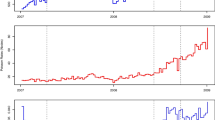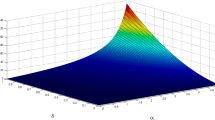Abstract
We propose a scale-free network model with a tunable power-law exponent. The Poisson growth model, as we call it, is an offshoot of the celebrated model of Barabási and Albert where a network is generated iteratively from a small seed network; at each step a node is added together with a number of incident edges preferentially attached to nodes already in the network. A key feature of our model is that the number of edges added at each step is a random variable with Poisson distribution, and, unlike the Barabási–Albert model where this quantity is fixed, it can generate any network. Our model is motivated by an application in Bayesian inference implemented as Markov chain Monte Carlo to estimate a network; for this purpose, we also give a formula for the probability of a network under our model.
Similar content being viewed by others
References
Albert R., Jeong H. and Barabási A.-L. (1999). Diameter of the world-wide web. Nature 401: 130–131
Albert R. and Barabási A.-L. (2000). Topology of evolving networks: local events and universality. Physical Review Letters 85: 5234–5237
Barabási A.-L. and Albert R. (1999). Emergence of scaling in random networks. Science 286: 509–512
Bauke H. (2007). Parameter estimation for power-law distributions by maximum likelihood methods. The European Physical Journal B Condensed Matter and Complex Systems 58(2): 167–173
Bianconi G. and Barabási A.-L. (2001). Competition and multiscaling in evolving networks. Europhysics Letters 54(4): 436–442
Boccaletti S., Latora V., Moreno Y., Chavez M. and Hwang D.-U. (2006). Complex networks: structure and dynamics. Physics Reports 4-5 424: 175–308
Bollobás B., Riordan O., Spencer J. and Tusanády G. (2001). The degree sequence of a scale-free random graph process. Random Structures Algorithms 18: 279–290
Dorogovtsev S.N., Mendes J.F.F., Samukhin and A.N. (2000). Structure of growing networks with preferential linking. Physical Review Letters 85: 4633–4636
Dorogovtsev S.N. and Mendes J.F.F. (2001). Effect of accelerated growth of communications networks on their structure. Physical Review E 63: 025101
Erdös P. and Rényi A. (1959). On random graphs I. Publicationes Mathematicae, 6: 290–297
Goldstein M.L., Morris S.A. and Yen G.G. (2004). Problems with fitting to the power-law distribution. The European Physics Journal B 41: 255–258
Jeong H., Mason S., Barabási A.-L. and Oltvai Z.N. (2001). Lethality and centrality in protein networks. Nature 411: 41–42
Krapivsky P.L., Redner S. and Leyvraz F. (2000). Connectivity of growing random networks. Physical Review Letters 85: 4629–4632
Krapivsky P.L. and Redner S. (2001). Organization of growing random networks. Physical Review E 63: 066123
Lee D.S., Goh K.I., Kahng B. and Kim D. (2005). Scale-free random graphs and Potts model. Pramana Journal of Physics 64: 1149–1159
Newman M.E.J. (2005). Power laws, Pareto distributions and Zipf’s law. Contemporary Physics 46(5): 323–351
Redner S. (1998). How popular is your paper? An empirical study of the citation distribution. The European Physics Journal B 4: 131–134
Sheridan, P., Kamimura, T., Shimodaira, H. (2007). Scale-free networks in Bayesian inference with applications to bioinformatics. Proceedings of The International Workshop on Data-Mining and Statistical Science (DMSS2007), 1–16, Tokyo.
Solé R.V., Pastor-Satorras R., Smith E. and Kepler T.B. (2002). A model of large-scale proteome evolution. Advances in Complex Systems 5: 43–54
Strogatz S.H. (2001). Exploring complex networks. Nature 410: 268–276
Watts D.J. and Strogatz S.H. (1998). Collective dynamics of small-world networks. Nature 393: 440–442
Author information
Authors and Affiliations
Corresponding author
About this article
Cite this article
Sheridan, P., Yagahara, Y. & Shimodaira, H. A preferential attachment model with Poisson growth for scale-free networks. Ann Inst Stat Math 60, 747–761 (2008). https://doi.org/10.1007/s10463-008-0181-5
Received:
Revised:
Published:
Issue Date:
DOI: https://doi.org/10.1007/s10463-008-0181-5




